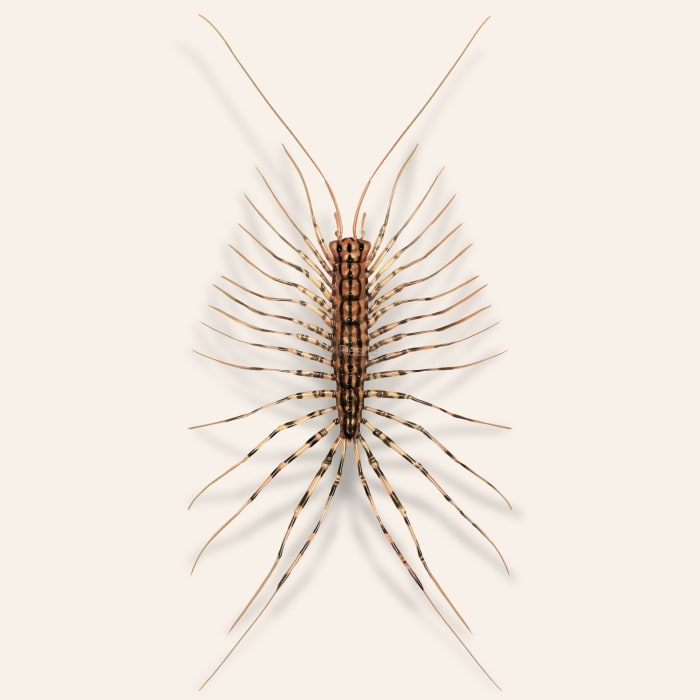How to identify and get rid of centipedes in your home

Legs for days: centipedes in your home
Seeing a critter skitter across your floor with what looks like a hundred legs can make anyone a little jumpy. But centipedes are just looking for their next meal, which is probably already inside your home!
Centipedes are a common household pest that goes chasing after other insects like silverfish, spiders, and cockroaches. Who’s the bad guy now?
While they may be doing more good than harm in your home, nobody wants a centipede for a house guest. Unlike other pest invaders, centipedes are pretty content to live their entire lives inside your home. They prefer to keep to dark and moist areas like basements, cellars, and bathrooms, but they have been known to live in attics or underneath the house, too.
Even though centipede literally means 100 legs, very few have that many. Depending on the species, most centipedes have anywhere from 15 to 191 pairs of legs. Each body segment gets a similar-looking pair of legs. However, the first and last pair are quite different.
The head has a pair of venomous mandibles used to capture and kill prey, while the last pair is used in mating or defense.
Outdoors, centipedes can be found in high moisture areas such as loose bark, under leaves and grass, under rocks, or in rotting wood. They are nocturnal hunters that have relatively poor eyesight. Instead, they rely on smell and touch to find their prey.
How to identify centipedes
Several species of centipedes are common in the United States. The most common centipede found in homes is the house centipede, Scutigera coleoptrata. These centipedes have 15 pairs of long legs; the last pair is sometimes twice as long as the body. The house centipede is yellow with black stripes on its body and legs.
A larger, more venomous centipede, Scolopendra heros, is found in the southern regions of the US. It is known as the giant desert centipede because it can get up to 7 inches long! You can identify it by its reddish-orange color and dark bands that separate each body segment. And be careful with both ends of this one: they have venomous pincers near the head and back. They are hard to squish, too!
There are several other species of centipedes, too, but the one thing they have in common is that they only have one pair of legs per body segment, while millipedes have two pairs of legs per body segment.
Fun fact
If you look at the legs of a centipede, you’ll always notice they come in an odd number of pairs, like 15, 35, or 171. You’ll never find a centipede with an even number of body segments! That means that a centipede can never have exactly 100 legs.
How to get rid of centipedes
Centipedes are looking for two things when they wander into your home: a warm, moist place to get out of the cold and new hunting grounds for small insects.
So, what’s the best way to keep centipedes out of your home? You need to eliminate the things they are looking for.
- First, use a dehumidifier to dry out basements or cellars of your home and fix any leaky pipes in bathrooms or near your water heater. Getting rid of any excessive moisture will make things uncomfortable for centipedes.
- Second, make sure you are decluttering your basements, crawlspaces, or attics where centipedes like to hide. Outside, try removing leaf litter, grass piles, and wood away from the home.
- Next, you may want to inspect your home for other pests that might be lurking nearby. Putting out sticky traps for cockroaches or silverfish can also help you monitor for these pests. You may need to address these pests before you can keep centipedes away.
- Lastly, if you can prevent centipedes from entering your home in the first place, you can reduce not only centipedes scurrying across your floor but other pests, too. That includes sealing up gaps or cracks around your home and weatherstripping doors and windows and maintaining your homes bug barrier with Pestie's Smart Pest Plan.
Treat centipedes with Pestie
If you're still having trouble keeping centipedes away, the best option is to use a pro-grade, effective pest control solution like Pestie.
Pestie is a do-it-yourself pest control solution that's specially designed to keep centipedes and other pests away from your home.
With Pestie, you can rest easy knowing that your living space is protected and free of creepy crawlies. And the best part? It's designed for people, pets, and the planet, so you can say goodbye to harsh chemicals and hello to peace of mind!
- Save hundreds compared to traditional annual pest plans
- People, pet, and planet-friendly
- Pro-grade customized formulas








